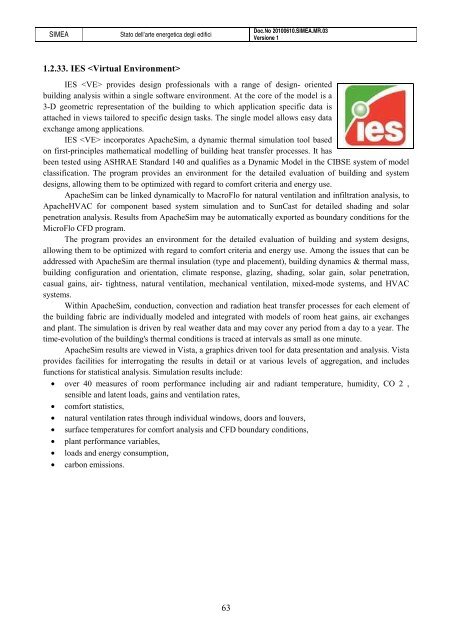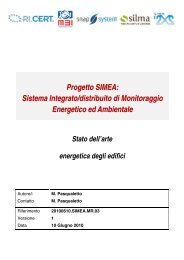Progetto SIMEA - Automatica - Università degli Studi di Padova
Progetto SIMEA - Automatica - Università degli Studi di Padova
Progetto SIMEA - Automatica - Università degli Studi di Padova
You also want an ePaper? Increase the reach of your titles
YUMPU automatically turns print PDFs into web optimized ePapers that Google loves.
<strong>SIMEA</strong> Stato dell’arte energetica <strong>degli</strong> e<strong>di</strong>fici<br />
1.2.33. IES <br />
63<br />
Doc.No 20100610.<strong>SIMEA</strong>.MR.03<br />
Versione 1<br />
IES provides design professionals with a range of design- oriented<br />
buil<strong>di</strong>ng analysis within a single software environment. At the core of the model is a<br />
3-D geometric representation of the buil<strong>di</strong>ng to which application specific data is<br />
attached in views tailored to specific design tasks. The single model allows easy data<br />
exchange among applications.<br />
IES incorporates ApacheSim, a dynamic thermal simulation tool based<br />
on first-principles mathematical modelling of buil<strong>di</strong>ng heat transfer processes. It has<br />
been tested using ASHRAE Standard 140 and qualifies as a Dynamic Model in the CIBSE system of model<br />
classification. The program provides an environment for the detailed evaluation of buil<strong>di</strong>ng and system<br />
designs, allowing them to be optimized with regard to comfort criteria and energy use.<br />
ApacheSim can be linked dynamically to MacroFlo for natural ventilation and infiltration analysis, to<br />
ApacheHVAC for component based system simulation and to SunCast for detailed sha<strong>di</strong>ng and solar<br />
penetration analysis. Results from ApacheSim may be automatically exported as boundary con<strong>di</strong>tions for the<br />
MicroFlo CFD program.<br />
The program provides an environment for the detailed evaluation of buil<strong>di</strong>ng and system designs,<br />
allowing them to be optimized with regard to comfort criteria and energy use. Among the issues that can be<br />
addressed with ApacheSim are thermal insulation (type and placement), buil<strong>di</strong>ng dynamics & thermal mass,<br />
buil<strong>di</strong>ng configuration and orientation, climate response, glazing, sha<strong>di</strong>ng, solar gain, solar penetration,<br />
casual gains, air- tightness, natural ventilation, mechanical ventilation, mixed-mode systems, and HVAC<br />
systems.<br />
Within ApacheSim, conduction, convection and ra<strong>di</strong>ation heat transfer processes for each element of<br />
the buil<strong>di</strong>ng fabric are in<strong>di</strong>vidually modeled and integrated with models of room heat gains, air exchanges<br />
and plant. The simulation is driven by real weather data and may cover any period from a day to a year. The<br />
time-evolution of the buil<strong>di</strong>ng's thermal con<strong>di</strong>tions is traced at intervals as small as one minute.<br />
ApacheSim results are viewed in Vista, a graphics driven tool for data presentation and analysis. Vista<br />
provides facilities for interrogating the results in detail or at various levels of aggregation, and includes<br />
functions for statistical analysis. Simulation results include:<br />
• over 40 measures of room performance inclu<strong>di</strong>ng air and ra<strong>di</strong>ant temperature, humi<strong>di</strong>ty, CO 2 ,<br />
sensible and latent loads, gains and ventilation rates,<br />
• comfort statistics,<br />
• natural ventilation rates through in<strong>di</strong>vidual windows, doors and louvers,<br />
• surface temperatures for comfort analysis and CFD boundary con<strong>di</strong>tions,<br />
• plant performance variables,<br />
• loads and energy consumption,<br />
• carbon emissions.
















